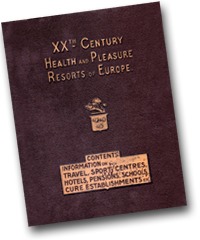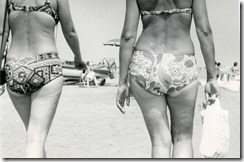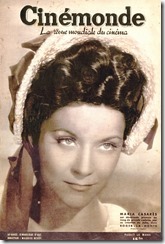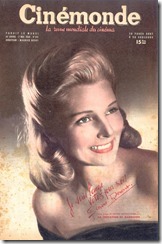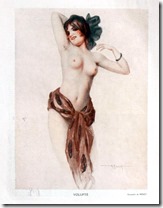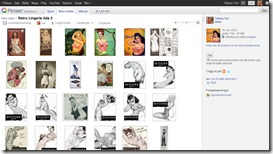And the lovely ladies are: Carol Hughes, Dorothy Short, Eleanor Holm, Jean Harlow, Joan Blondell, Laurie Lane, Lilian Bond, Lupe Velez, Mary Carlisle, Olivia De Havilland, Patricia Ellis, Paulette Goddard, Raquel Torres and Sally Blane.
Archive for the ‘Image Gallery’ Category
Let’s Indulge In A Little 1930s Glamour
Posted in Actresses, Image Gallery, The thirties, tagged Carol Hughes, Dorothy Short, Eleanor Holm, Jean Harlow, Joan Blondell, Laurie Lane, Lilian Bond, Lupe Velez, Mary Carlisle, Olivia De Havilland, Patricia Ellis, Paulette Goddard, Raquel Torres on January 30, 2015| 6 Comments »
Another Vintage Easy Chair Round Trip Anno 1885 – 1910
Posted in Holidays, Image Gallery, Postcards, Traveling, Vintage photography, tagged Easy chair travveling, Old postcards on October 31, 2014| Leave a Comment »
Charles Dana Gibson – The Social Ladder
Posted in Illustration, Image Gallery, tagged Charles Dana Gibson, The Gibson Girl on September 21, 2014| 2 Comments »
Pen illustrations by Charles Dana Gibson, the creator of the Gibson Girl.
Images found at moica-palace
Yes….I Think It Is Time For Some More……
Posted in Actresses, Image Gallery, Models & starlets, tagged Jayne Mansfield on September 9, 2014| 1 Comment »
….Jayne Mansfield
Jayne was born Vera Jayne Palmer on April 19, 1933 in Pennsylvania and she is to day, more than 30 years after her death. one of the shining stars of the middle of the last century. Poor Jayne is to day where she always wanted to be, out of Monroe’s shadow.
Most of her fame was build on her relentless, shameless self promotion, she only had two really successful movies and one Broadway hit. Jayne loved Hollywood and every experience it had to offer. Few starlets climbing to the top of stardom embraced the effect that stardom brought as fiercely as Mansfield did. Most stars are complaining earnestly or in pretence the burden fame brings. Jayne never considered it a burden, she wallowed in it. She is one of the most remembered icons of the 50’ies to day. And Jayne deserves it, lets give her that.
I have always had a deep respect for people who live without pretence, people who does not surrender to the numbness of conformity that most of us do.
Thanks for everything Jayne
There has never been many like you around – Ted
The History Of Sidecars
Posted in Image Gallery, Motorcycles, tagged Mr M Bertoux, Sidecars, Swallow Sidecar Company, Watsonian Squire on September 6, 2014| 9 Comments »
A sidecar is a one-wheeled device attached to the side of a motorcycle, scooter, or bicycle, producing a three-wheeled vehicle. A motorcycle with a sidecar is sometimes called a combination, an outfit, a rig or a hack.
History
Mr M Bertoux, a French army officer, secured a prize offered by a French newspaper in 1893 for the best method of carrying a passenger on a bicycle. The sidecar wheel was mounted on the same lateral plane as the bicycle’s rear and was supported by a triangulation of tubes from the bicycle. A sprung seat with back rest was mounted above the cross-member and a footboard hung below. A sidecar appeared in a cartoon by George Moore in the January 7, 1903, issue of the British newspaper Motor Cycling. Three weeks later, a provisional patent was granted to Mr. W. J. Graham of Graham Brothers, Enfield, Middlesex. He partnered with Jonathan A. Kahn to begin production.
One of Britain’s oldest sidecar manufacturers, Watsonian, was founded in 1912. It is still trading as Watsonian Squire. Automobile producer Jaguar Cars was founded in 1922 as a sidecar manufacturer, the Swallow Sidecar Company.
In 1913, American inventor Hugo Young, of Loudonville, Ohio, designed a new sidecar which was not rigidly fixed to the motorcycle. Instead, his invention employed a flexible connection, which allowed the sidecar to turn, raise, and lower without affecting the balance of the motorcycle. This was a great improvement over the original design, allowing for much safer and more comfortable experiences for both the passenger and driver. Young opened up the Flxible Sidecar Company (the first "e" was dropped to allow for trademarking the name) in Loudonville, Ohio and soon became the largest sidecar manufacturer in the world. When the motorcycle craze began to fade in the 1920s due to more affordable cars being marketed, as well as the banishment of sidecar racing in the United States, the Flxible Sidecar Company began producing transit buses, ambulances, and hearses. Until the 1950s sidecars were quite popular, providing a cheap alternative to passenger cars; they have also been used by armed forces, police and the UK’s AA and RAC motoring organisations. During World War II, German troops used many BMW and Zündapp sidecar motorcycles. On German, French, Belgian, British and Soviet military sidecars, the side wheel was sometimes also driven, sometimes using a differential gear, to improve the vehicle’s all-terrain ability.
Text from Wikipedia
Photographer Captures England Through A 130-Year-Old Camera That Needs Up To 15 Minutes To Take A Shot
Posted in Image Gallery, People, Photography, tagged Jonathan Keys, Unusual photographic processes on June 2, 2014| Leave a Comment »
British photographer Jonathan Keys certainly stands out among contemporary photographers for his unusual photographic process, which brings the long-lost past and the present together. For starters, he uses a rare but still functional 130-year-old wooden Circa camera that requires about 15 minutes to finish one shot.See the rest of the pictures on BoredPanda
XXth Century Health & Pleasure Resorts Of Europe – Part 12
Posted in Holidays, Image Gallery, The thirties, Traveling, tagged 1933, Shipping lines, Traveling agencies on March 17, 2014| Leave a Comment »
From the 33rd edition of “XXth Century Health And Pleasure Resorts Of Europe” published in 1933
It looks like a full page ads in this publication was pretty pricy as there was rather few of them. Few of them were for holiday and health resorts as well, but rather for large traveling bureaus and shipping lines. Here are the lot of them – Ted
 |
 |
 |
 |
 |
 |
 |
 |
 |
 |
 |
 |
 |
 |
 |
Joseph Kuhn-Régnier – French Illustrator
Posted in Illustration, Image Gallery, Nudes, tagged French illustrators, Joseph Kuhn-Régnier on March 4, 2014| 4 Comments »
Joseph Kuhn-Régnier, born Joseph Louis Wilfrid Kuhn-Regnier (10 December 1873 – 1940), was a French illustrator who worked in Paris. His work is recognizable by his characters inspired by Greek and classical art. He contributed full-page colored illustrations and advertisements to society magaziness between 1911 and 1934 such as La Vie Parisienne, Fantasio, and Le Sourire. In 1934 he created colored illustrations for four volume collection The Works of Hippocrates, published by Javal & Bourdeaux in Paris. He also created illustrations for the erotic work The Songs of Bilitis in the 1930s.
Text from Wikipedia
Alfred Cheney Johnston’s Ziegfeld Girls
Posted in Image Gallery, Models & starlets, tagged Alfred Cheney Johnston, Ziegfeld girls on March 4, 2014| 2 Comments »


Kaja Eric – Claudia Dell 

Claudia Dell – Dolores Costello 


Dorothy Wegman – Hazel Forbes – Helen Lee Worthing 


Jeanne Eagles – Marion Davis – Ruby Keeler 


Mary Eaton – Muriel Finley – Muriel Finley 


Drucilla Strain – Kay English – Jean Ackerman
All images found on trialsanderrors’s photostream on Flickr
You can read a whole book on the Ziegfeld Girls here:
ZIEGFELD GIRL Image and icon in culture and cinema
Published by Duke University Press in 1999
“Baker In The Boudoir,” Playboy – December 1964
Posted in Actresses, Image Gallery, Models & starlets, Nudes, tagged American actresses, Carol Baker on February 8, 2014| Leave a Comment »
In Context
Carroll Baker (born May 28, 1931) is a former American actress who has enjoyed popularity as both a serious dramatic actress and, particularly in the 1960s, as a movie sex symbol. Despite being cast in a wide range of roles during her heyday, Baker’s beautiful features, blonde hair, and distinctive drawl made her particularly memorable in roles as a brash, flamboyant woman.
Image found at VintageBooty
The "Spruce Girls" 1929
Posted in Image Gallery, People, Photography, The twenties, Vintage, tagged 1929, Gray Harbor lumber industry, The Spruce Girls, Washington on February 5, 2014| 1 Comment »
 "Spruce Girls" on beach wearing spruce wood veneer bathing suits during "Wood Week" to promote products of the Gray Harbor lumber industry, Hoquiam, Washington, ca. 1929
"Spruce Girls" on beach wearing spruce wood veneer bathing suits during "Wood Week" to promote products of the Gray Harbor lumber industry, Hoquiam, Washington, ca. 1929
Bathing suits in veneer should be a fascinating if the girls stayed in the water long enough. Particularly as thin has that veneer seams to be. It splitts up easily then – Ted
Images found at:
University of Washington Libraries Digital Collections
on Flickr

Three "Spruce Girls" wearing wood veneer bathing suits sitting under an umbrella and holding wooden boards shaped like feet.
Four "Spruce Girls" wearing wood veneer bathing suits standing in the surf.
Some Photographers Seam To Always Find The Right Motives
Posted in Image Gallery, Photography, tagged Beach, Bums on January 30, 2014| Leave a Comment »
Duo-Colour Cinémonde Covers
Posted in Ephemera, Image Gallery, Photography, Portraits, The fifties, The forties, tagged Cinémonde, Covers, Duo-Colours on January 27, 2014| 2 Comments »
Paris-Hollywood Covers
Posted in Image Gallery, Models & starlets, Photography, Pinups, tagged Magazine covers, Paris-Hollywood on January 20, 2014| 2 Comments »





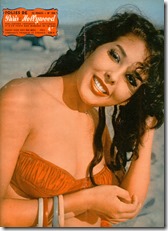




I shouldn’t think this gallery needs much in the way of text at all –Ted
Images found at Agence Eureka – A marvellous site crammed with old printed matter.
Memories Of Summer
Posted in Glamour, Image Gallery, Models & starlets, tagged Summer on January 14, 2014| 1 Comment »
Girls playing cards and drinking Coca-Cola
Posted in Image Gallery, People, Photography, tagged 1941, Arthur Siegel on December 10, 2013| Leave a Comment »

Detroit. "Summer 1941. Girls playing cards and drinking Coca-Cola." Which is how these things often begin. The first in a curious series of photos taken by Arthur Siegel for the Office of War Information. More to come.
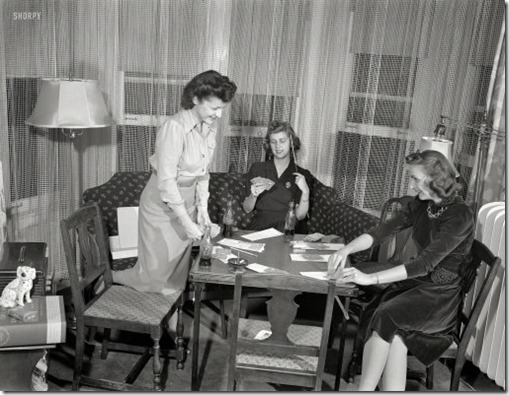
Detroit. "Summer 1941. Girls playing cards and drinking Coca-Cola." Our second look at a series of photos taken by Arthur Siegel for the Office of War Information. What game, exactly, are these girls up to?

Detroit, summer 1941. Our third look at a series of photos taken by Arthur Siegel for the Office of War Information. The first few are labeled "Girls playing cards and drinking Coca-Cola." Then the caption disappears, and the rest of the photos bear the notation "This image in jacket marked ‘killed’."

The next entry in this curious series of photos from the Office of War Information archive, taken by Arthur Siegel in the summer of 1941 in Detroit. We’re now well into the subset of pictures bearing the notation "This image in jacket marked ‘Killed’."
"Detroit, Michigan. Girls playing cards and drinking Coca-Cola."

The stakes in this cryptic card game are getting both higher and lower.
Summer 1941. "Detroit, Michigan. Girls playing cards and drinking Coca-Cola." Photo by Arthur Siegel for the Office of War Information.

Detroit, summer 1941. "Girls playing cards and drinking Coca-Cola." The card table seems to have turned in this seventh installment of Arthur Siegel’s mysterious photos for the Office of War Information.

It’s getting … so hot in here. "Summer 1941. Detroit, Michigan. Girls playing cards and drinking Coca-Cola." The next entry in this curious series snapped by Arthur Siegel for the Office of War Information.
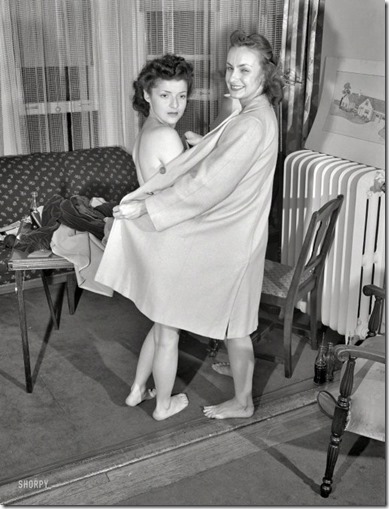
"Summer 1941. Detroit, Michigan. Girls playing cards and drinking Coca-Cola." The game seems to be winding up in this series of photos by Arthur Siegel, with these two having lost their shirts. Or something like that.
Photo series and captions found on Shorpy
Paris Plaisirs – French Magazine
Posted in Article, Glamour, Image Gallery, Models & starlets, Nudes, Vintage photography, tagged French magazinees, Old magazines, Paris Plaisirs on November 26, 2013| Leave a Comment »
Another favorite French magazine of the 1920s and 1930s is the, mostly unknown, Paris Plaisirs. It is comparable to the legendary, large format art deco era, La Vie Parisienne in style and size, while focusing on the stars of the music-hall. Paris Plaisirs also differed in another major aspect: it used photographs as well as illustrations in each issue. Many covers featured the creativity of Austrian photographer Manasse.
Part of the attraction of Paris Plaisirs, besides the obvious, is the amazing (unintentional) lines created by the French in the way they used images of women as the seductress. The representations ranged from hard boiled, tough girl, Kiki de Montparnasse (above) to passive posing (cover below) to all out femmes fatale as seen in most of the remaining covers in this post. Later, in the early 1930s, Paris Plaisirs and many other European pop-culture magazines recognized the attraction of Hollywood celebrity. In the last two covers, this "magazine tres Parisian", puts two major American movie stars on covers: first Ginger Rogers and on the final cover in this post, Jean Harlow.
Note that all the photographs used in Paris Plaisirs were made in black and white as the first true color film was not available until 1937. The creative solution was quite ingenious and used to lesser and greater success by many publishers. A "color separator" working with a "colorist" would create areas of color in solids, shades and tones similar to the method used to color the artwork for comic books. Other than the techniques needed to make this process convincing was the necessity to let the photo "come through" the colorization and not creating an illustration.
Interior pages of photos and illustrations and front covers follow without captions and in no particular order. Click on each image and a larger version of the scan will open in the same window.
Text from vasta-images-books
Retro Lingerie Ads
Posted in Advertising, Advertisments, Image Gallery, Retro, Vintage, tagged Lingerie, Lingerie ads on November 21, 2013| 4 Comments »
 I grew up in a religious home (believe it or not) so there was no men’s magazine to sneak a peek at for young Ted so the closest thing to glamour photographies I could lay my eyes on were lingerie ads in the family magazine my parents held. Still to day if I see a retro lingerie ad I smile to myself remembering the excitement those ads brought way back then.
I grew up in a religious home (believe it or not) so there was no men’s magazine to sneak a peek at for young Ted so the closest thing to glamour photographies I could lay my eyes on were lingerie ads in the family magazine my parents held. Still to day if I see a retro lingerie ad I smile to myself remembering the excitement those ads brought way back then.
Here’s a gallery full of old lingerie ads for you in case you have similar memories. Hit the image below for the gallery.
80 Years Of Advertising Artwork – 1900-1920 – Intro
Posted in Advertisments, Design, Illustration, Image Gallery, Photography, tagged Advertising Artwork on November 21, 2013| Leave a Comment »
At the turn of the century there was a marked difference between the mood of the Old World and the New. The United States, with its vast stretches of unoccupied territory, was indeed the Promised Land. This feeling of general optimism was merely heightened in 1901 when Theodore Roosevelt, the country’s youngest and most energetic President, strode into the White House promising everyone a ‘square deal’.
In contrast, England’s mood was cautious, even apprehensive. Maintaining an Empire had its physical, financial, and moral problems. In 1901 Queen Victoria, revered image of an age that bore her name, died, and with her went the sense of security her people had enjoyed for more than sixty years. There was a rumour that Germany was studying plans for an invasion of England. No one really believed it, yet in 1903 when the Wright Brothers proved at Kitty Hawk that men could fly, and within six years Bleriot succeeded in flying across the English Channel in twenty-six minutes, England’s cheers changed to shocked silence as she realized the significance of what had happened.
By now, another wonder, the ‘horseless carriage’, had become the toy of the rich. While proud owners were having the time of their lives, others who still preferred horses to horsepower and couldn’t afford not to resented being coated with dust every time a ‘wretched’ car went hooting and bumping past. But nothing could prevent the inevitable, and in 1908 when Henry Ford introduced his Model T, the first massproduced car, a new age of motoring began.
 Despite disturbing undercurrents of ‘progress’, the Edwardians, led by the most pleasure-loving of monarchs, Edward VII, adored pretty faces and lobsters for tea, were as good at playing ostrich as the ladies were at feathering their hats. They sat down to six-course dinners, dressed to the nines for Ascot, watched a little tennis at Wimbledon and cricket at Lord’s, played the new game of Ping-Pong, and fled to the Riviera at chilblain time. American millionaires, before opening their seaside’ cottages’ at Newport, Bar Harbor, or Southampton, might take the Grand Tour of Europe, stopping en route in England to choose, perhaps, a Rolls-Royce or to marry a title.
Despite disturbing undercurrents of ‘progress’, the Edwardians, led by the most pleasure-loving of monarchs, Edward VII, adored pretty faces and lobsters for tea, were as good at playing ostrich as the ladies were at feathering their hats. They sat down to six-course dinners, dressed to the nines for Ascot, watched a little tennis at Wimbledon and cricket at Lord’s, played the new game of Ping-Pong, and fled to the Riviera at chilblain time. American millionaires, before opening their seaside’ cottages’ at Newport, Bar Harbor, or Southampton, might take the Grand Tour of Europe, stopping en route in England to choose, perhaps, a Rolls-Royce or to marry a title.
In 1910 King Edward died, and George V succeeded. Two American men of letters died that year also, Mark Twain and O. Henry. H. G. Wells, very much alive, came out with two new books, Edith Wharton finished Ethan Frome, and John Galsworthy‘s play, Justice, was produced. In New York Caruso sang at the Metropolitan in Puccini’s new opera Girl of the Golden West. Broadway also had a new Victor Herbert hit, Naughty Marietta, a new clown, Fanny Brice, in The Ziegfeld Follies of 1910, and a slightly older clown, Marie Dressler, singing ‘Heaven Will Protect the Working Girl’ in Tillie’s Nightmare.
 It was a good season, too, for those whose idols included Marie Tempest, John Drew, Minnie Maddern Fiske, Maude Adams, Otis Skinner, John Barrymore and his sister Ethel. In 1910 Mrs. Patrick Campbell was onstage in The Foolish Virgin, but her greatest triumph was to come in 1914 as Eliza Doolittle in George Bernard Shaw’s Pygmalion. That was the year Somerset Maugham finished writing his greatest novel, On Human Bondage.
It was a good season, too, for those whose idols included Marie Tempest, John Drew, Minnie Maddern Fiske, Maude Adams, Otis Skinner, John Barrymore and his sister Ethel. In 1910 Mrs. Patrick Campbell was onstage in The Foolish Virgin, but her greatest triumph was to come in 1914 as Eliza Doolittle in George Bernard Shaw’s Pygmalion. That was the year Somerset Maugham finished writing his greatest novel, On Human Bondage.
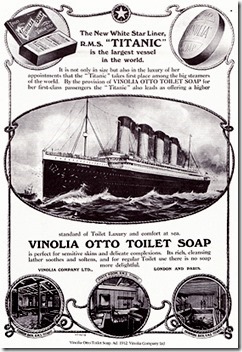 In 1912 the White Star Line’s Titanic, the biggest, most glamorous ‘floating hotel’ ever known, struck an iceberg on her maiden voyage to New York and sank with the loss of fourteen hundred and ninety lives. Bernard Shaw, often consulted on matters of topical interest because he could be counted on for good newspaper copy, criticized the gross mismanagement of the captain and crew instead of praising their heroism. This caused great public dismay and aroused a furious Conan Doyle to call Shaw a sadist. No disaster had made such headlines since the San Francisco earthquake and fire of 1906.
In 1912 the White Star Line’s Titanic, the biggest, most glamorous ‘floating hotel’ ever known, struck an iceberg on her maiden voyage to New York and sank with the loss of fourteen hundred and ninety lives. Bernard Shaw, often consulted on matters of topical interest because he could be counted on for good newspaper copy, criticized the gross mismanagement of the captain and crew instead of praising their heroism. This caused great public dismay and aroused a furious Conan Doyle to call Shaw a sadist. No disaster had made such headlines since the San Francisco earthquake and fire of 1906.
Three of the century’s greatest cultural developments occurred between 1910 and 1920. One was the Russian Ballet, organized by Diaghilev in 1909 in Paris, danced in London in 1911 with Thomas Beecham conducting the orchestra and in New York five years later. Nothing like this had been seen before. It was not only the dancing of Nijinsky, Karsavina, and company, or the music of Stravinsky, Debussy, and Ravel, or the fantastic settings by Bakst, Goncharova, Picasso, and Chagall; it was the total kaleidoscopic effect of the three integrated marvels, an advantage so lacking, for instance, in the solo and sceneless performances of the great Anna Pavlova after she. left Diaghilev.
More universal was the influence of jazz, which came out of the South, New Orleans most famously, and developed into the well-known derivatives danced to from the days of Irving Berlin’s Alexander’s Ragtime Band in 1911, through the Harlem nightclub era of the twenties, to today.
The third big contribution to the arts was the motion picture, which in twelve years had developed from a flickering nickelodeon novelty, The Great Train Robbery of 1903, into the art form created by D. W. Griffith in his full-length Birth of a Nation. Aided by the popularity of Lillian Gish, Mary Pickford, Douglas Fairbanks, Charlie Chaplin, and others who deserted the stage for Hollywood, motion pictures were becoming the world’s favourite form of entertainment. In the fine arts, popular taste was meeting new challenges.
French impressionist and post-impressionist painting, exhibited for the first time in London in 1905 and 1910 respectively, was not at all appreciated, and in the Armory Show of 1913 in New York when expressionism, futurism, fauvism and cubism were first seen, much ofthe public was  outraged. Said one young man, aghast at Marcel Duchamp’s abstract Nude Descending a Staircase, ‘If that’s the way women are going to look in the future, I’m off girls.’ Gibson’s (Left) were more to the taste so, even, was Whistler’s Mother.
outraged. Said one young man, aghast at Marcel Duchamp’s abstract Nude Descending a Staircase, ‘If that’s the way women are going to look in the future, I’m off girls.’ Gibson’s (Left) were more to the taste so, even, was Whistler’s Mother.
Industrialist Frank Pick, of the London Underground Railways, was farsighted enough to see the value of art in advertising, and before World War I was commissioning work by artists of the stature of Frank Brangwyn and Spencer Pryce. Among his discoveries was Montana-born Edward McKnight Kauffer, whose Underground posters became world famous in the twenties through the forties.
 John Hassall’s ‘Skegness’ is typical of the jolly, infectious poster the English loved in the 1910s-and still do. Tom Browne’s Johnnie Walker’ ad, used in adaptations ever since, first appeared in 1906. Leonetto Cappiello, Cecil Aldin, Tony Sarg, Hans Rudi Erdt, and Ludwig Hohlwein were other leading designers of the period. In America Palmer Cox, Maxfield Parrish, J. C. Leyendecker, and Coles Phillips were making brand names familiar household words.
John Hassall’s ‘Skegness’ is typical of the jolly, infectious poster the English loved in the 1910s-and still do. Tom Browne’s Johnnie Walker’ ad, used in adaptations ever since, first appeared in 1906. Leonetto Cappiello, Cecil Aldin, Tony Sarg, Hans Rudi Erdt, and Ludwig Hohlwein were other leading designers of the period. In America Palmer Cox, Maxfield Parrish, J. C. Leyendecker, and Coles Phillips were making brand names familiar household words.
In 1914 when a Serbian nationalist murdered Archduke Franz Ferdinand, heir to the Austrian Empire, the curtain arose on one of the most terrible dramas in European history-the Great War. To begin with, recruits were made up of volunteers, and poster artists such as Alfred Leete were called upon to switch from selling products with a smile to playing on human emotions.


After three years of utter horror at the front, Great Britain and France were joined by the United States, bringing the tragedy to an end on November 11, 1918. Meanwhile, in 1917, the Bolsheviks murdered the Russian Czar and his family to put into practice the theory of communism.
| Text from “The Art of ADVERTISING” by Bryan Holme |  Click Thumbnail for gallery featuring advertising artwork from 1990 – 1920 |



















